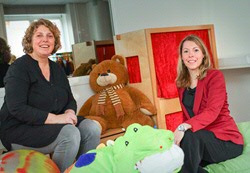Doofblinden hebben plezier dankzij zintuigenverhalen

Communiceren met mensen met doofblindheid of doofheid in combinatie met een verstandelijke beperking is bijzonder ingewikkeld. De Rijksuniversiteit Groningen onderzoekt samen met Koninklijke Kentalis of zintuigenverhalen – verhalen die via bijvoorbeeld geur of aanraking verteld worden – kunnen helpen om deze communicatie te verbeteren. Het doel: ervoor zorgen dat deze mensen en hun naasten op een plezierige manier even met hetzelfde onderwerp bezig kunnen zijn. Het onderzoek loopt nog, maar de eerste reacties zijn positief.
Tekst: Beau Oldenburg / Foto’s: Henk Veenstra
Carnavalshoedje
De doofblinde Gijs zit voorovergebogen in zijn elektrische rolstoel, diep in zijn eigen wereld verzonken. Zijn begeleider loopt naar hem toe en pakt voorzichtig zijn handen vast. Gijs veert op en gaat wat rechter zitten. De begeleider beweegt zachtjes een slinger met rode sliertjes langs zijn gezicht en handen. Gijs pakt de sliertjes vast en er verschijnt een lach op zijn gezicht. Dan geeft de begeleider hem een feesthoedje met zilveren pailletten aan. Gijs laat zijn vingers over de pailletten glijden en stopt de rand van het hoedje in zijn mond. Hij lacht van oor tot oor, want hij herkent het: hij droeg dit hoedje op die ene gezellige carnavalsmiddag.
Zintuigenverhalen
Het verhaal wat aan Gijs verteld werd, is een zogenaamd zintuigenverhaal. Deze verhalen maken gebruik van de zintuigen zoals geur en aanraking. Saskia Damen van de Rijksuniversiteit Groningen onderzoekt samen met Rita Gerkema-Nijhof van Koninklijke Kentalis welke effecten zintuigenverhalen hebben op mensen met doofblindheid en mensen met doofheid in combinatie met een verstandelijke beperking en hun naasten.
Meer contact
De onderzoekers hopen dat de zintuigenverhalen helpen om de communicatie met deze groep te verbeteren. Damen: ‘Naast zintuiglijke beperkingen heeft onze doelgroep vaak ook een beperkt begripsvermogen. Door de meervoudige beperkingen kan het lastig zijn om met ze te communiceren, maar dit is wel heel belangrijk. Als iemand met doofblindheid te weinig contact met anderen heeft, kan die persoon zich teveel in zijn of haar eigen wereld terugtrekken.’
Eerdere ervaringen
De meeste zintuigenverhalen gaan over leuke dingen die iemand heeft meegemaakt. Zoals de carnavalsmiddag van Gijs. Damen: ‘Je kunt doofblinde mensen moeilijk vertellen over iets wat ze nog niet kennen. Het is bijvoorbeeld nu winter. Als je daar een verhaal over wilt vertellen, kun je het beste eerst met de cliënt naar buiten gaan, blaadjes aanraken, voelen dat het een beetje koud en nat is en misschien nog een kop warme chocolademelk drinken ter afsluiting. Later kun je dan op al deze ervaringen teruggrijpen en er een verhaal van maken.’

Maatwerk
Doordat er gebruik wordt gemaakt van persoonlijke ervaringen zijn de zintuigenverhalen maatwerk. Damen en Gerkema-Nijhof werken dan ook niet aan een bundel met kant-en-klare verhalen maar zijn bezig met een soort gebruiksaanwijzing. Ze onderzoeken welke manieren van vertellen aanslaan en welke verhaalelementen het meest geschikt zijn. Met deze inzichten kunnen ze naasten en begeleiders beter trainen en ondersteunen zodat zij ook zelf hun eigen verhalen kunnen samenstellen.
Samen plezier maken
Gerkema-Nijhof: ‘De zintuigenverhalen zijn in de eerste plaats een prettige vorm van contact tussen de cliënt en diens naasten of begeleiders. Het is voor hen heel bijzonder om het even over hetzelfde onderwerp te kunnen hebben, om hun aandacht samen op iets te richten.’ Een mooie bijkomstigheid is volgens Gerkema-Nijhof dat de verhalen ook voor vermaak zorgen. ‘Een moeder van een cliënt hoorde haar kind lachen toen de begeleider een zintuigenverhaal vertelde. Ze was verrast en zei: ik hoor mijn kind lachen, dat doet hij bijna nooit!’
Opstapje
Op de lange termijn zorgen de verhalen er mogelijk voor dat mensen met doofblindheid of doofheid in combinatie met een verstandelijke beperking hun communicatiemogelijkheden verder ontwikkelen, iets wat lastig maar zeker niet onmogelijk is. Gerkema-Nijhof: ‘Hoeveel mensen precies leren, hangt van de ernst van hun problematiek af, maar we hopen dat de zintuigenverhalen een opstapje kunnen zijn naar het zelf vertellen van een verhaal. Bijvoorbeeld doordat iemand een nieuw gebaar of woord leert. Samen contact hebben over hetzelfde onderwerp is een eerste stap in leren communiceren.’

Betrouwbaarheid
De onderzoekers maken video-opnames als de verhalen verteld worden. Dat doen ze om de degene die het zintuigenverhaal vertelt gericht feedback te kunnen geven. Daarnaast vormen de videobeelden de onderzoeksdata. Ze analyseren de videobeelden om te bekijken welk effect de zintuigenverhalen hebben. Een van de belangrijkste uitdagingen in het onderzoek is om dit op een zo systematisch mogelijke wijze te doen. Damen: ‘Het is heel belangrijk dat de onderzoeksassistenten die de video’s gaan analyseren weten waar ze op moeten letten. Je moet ze dus goed trainen. Dit kan bijvoorbeeld met behulp van oefenfilmpjes. Ik heb er vertrouwen in dat we dit uiteindelijk op een goede manier kunnen doen, maar het kan wel een tijd duren voor we zover zijn.’
Plezier meten
Een andere uitdaging is de vraag hoe je precies kunt vastleggen of degene die het verhaal vertelt en de persoon met doofblindheid ook daadwerkelijk met hetzelfde onderwerp bezig zijn, en ze samen plezier hebben. Gerkema-Nijhof: ‘Naar gedeelde aandacht is al meer onderzoek gedaan en daar kunnen we op voortborduren, maar over gedeeld plezier is er bij deze groep nog niet veel bekend. Plezier kun je niet altijd aan de buitenkant zien. Een glimlach hoeft bijvoorbeeld niet per se te betekenen dat iemand het naar zijn zin heeft, maar kan ook spanning zijn. We moeten daarom per persoon vooraf afspreken hoe we dat meten, hoe die persoon plezier uit.’
Enthousiaste reacties
Het onderzoek is nog in volle gang, maar in de praktijk zien Damen en Gerkema-Nijhof al enthousiaste reacties. Rita Gerkema-Nijhof: ‘We zien dat deze verhaalmethode zowel de cliënt als ouder of begeleider erg aanspreekt. Er is plezier, er wordt veel gelachen. Als ouders het idee hebben dat hun kinderen iets niet leuk vinden, dan gaan ze hen daar niet mee vermoeien. Maar als ze plezier zien bij hun kinderen willen ze dat nog een keer zien. Daar worden ze blij van.’
Meer nieuws
-
08 december 2025
Burgerparticipatie onmisbaar voor een duurzame energietoekomst
-
23 oktober 2025
Negen wetenschappers van de RUG ontvangen Vidi-beurs
